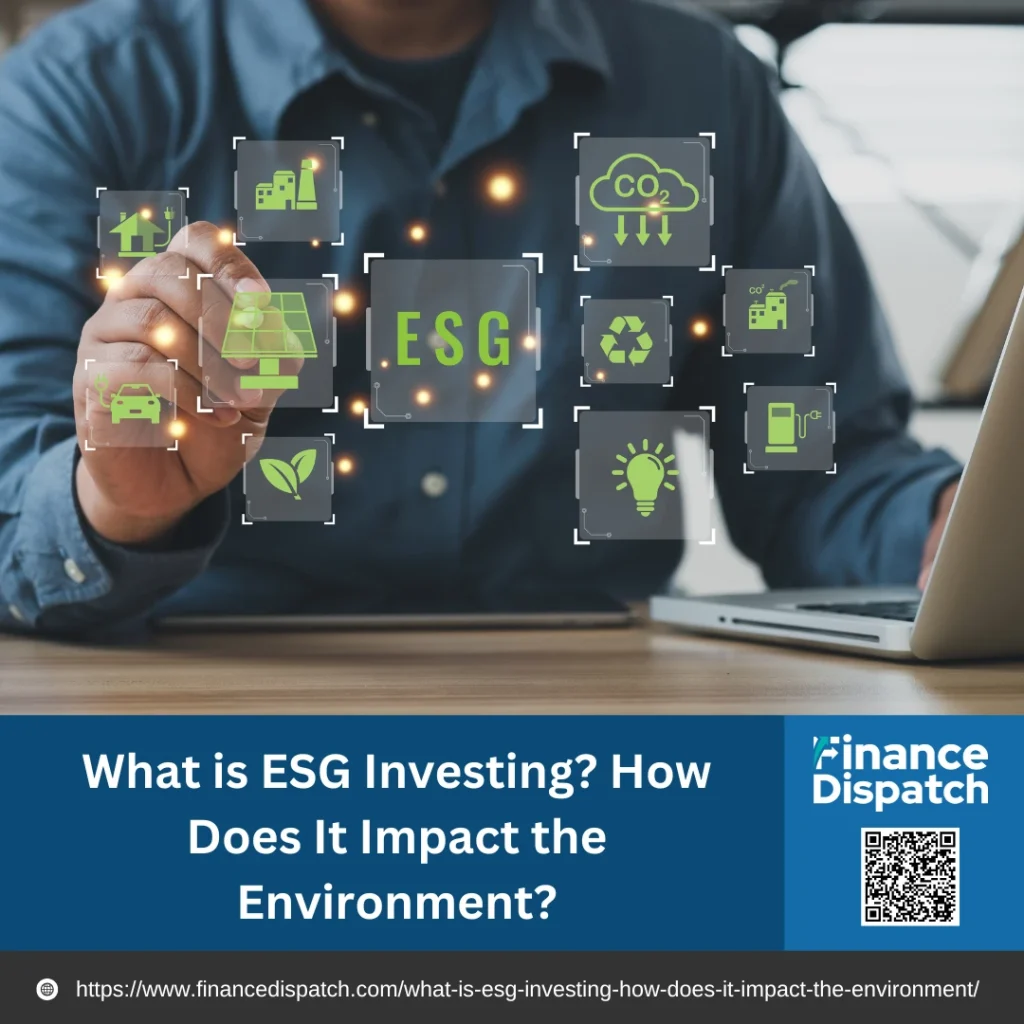In today’s rapidly evolving financial landscape, investors are looking beyond traditional profit-driven strategies and embracing a more responsible approach—ESG investing. Standing for Environmental, Social, and Governance, ESG investing integrates sustainability factors into financial decision-making, ensuring that companies not only generate returns but also contribute positively to society and the planet. With climate change, pollution, and resource depletion becoming urgent global concerns, ESG investing has gained momentum as a powerful tool to drive environmental responsibility. But how exactly does it impact the environment? From funding renewable energy projects to discouraging unsustainable corporate practices, ESG investing plays a crucial role in shaping a greener future. This article explores what ESG investing entails and how it actively influences environmental sustainability.
What is ESG Investing?
ESG investing refers to the practice of considering Environmental, Social, and Governance factors when making investment decisions. While traditional investing focuses primarily on financial returns, ESG investing takes a broader approach, evaluating how a company’s operations affect the environment, society, and its internal management practices. The Environmental component looks at a company’s sustainability efforts, such as its carbon footprint, waste management, and resource conservation. The Social aspect assesses how companies treat their employees, customers, and communities, with a focus on diversity, human rights, and labor practices. Finally, Governance evaluates a company’s leadership, transparency, and ethical conduct, including board diversity and executive compensation. By factoring in these non-financial elements, ESG investing allows investors to align their portfolios with their values, supporting companies that are committed to long-term sustainability and positive social impact.
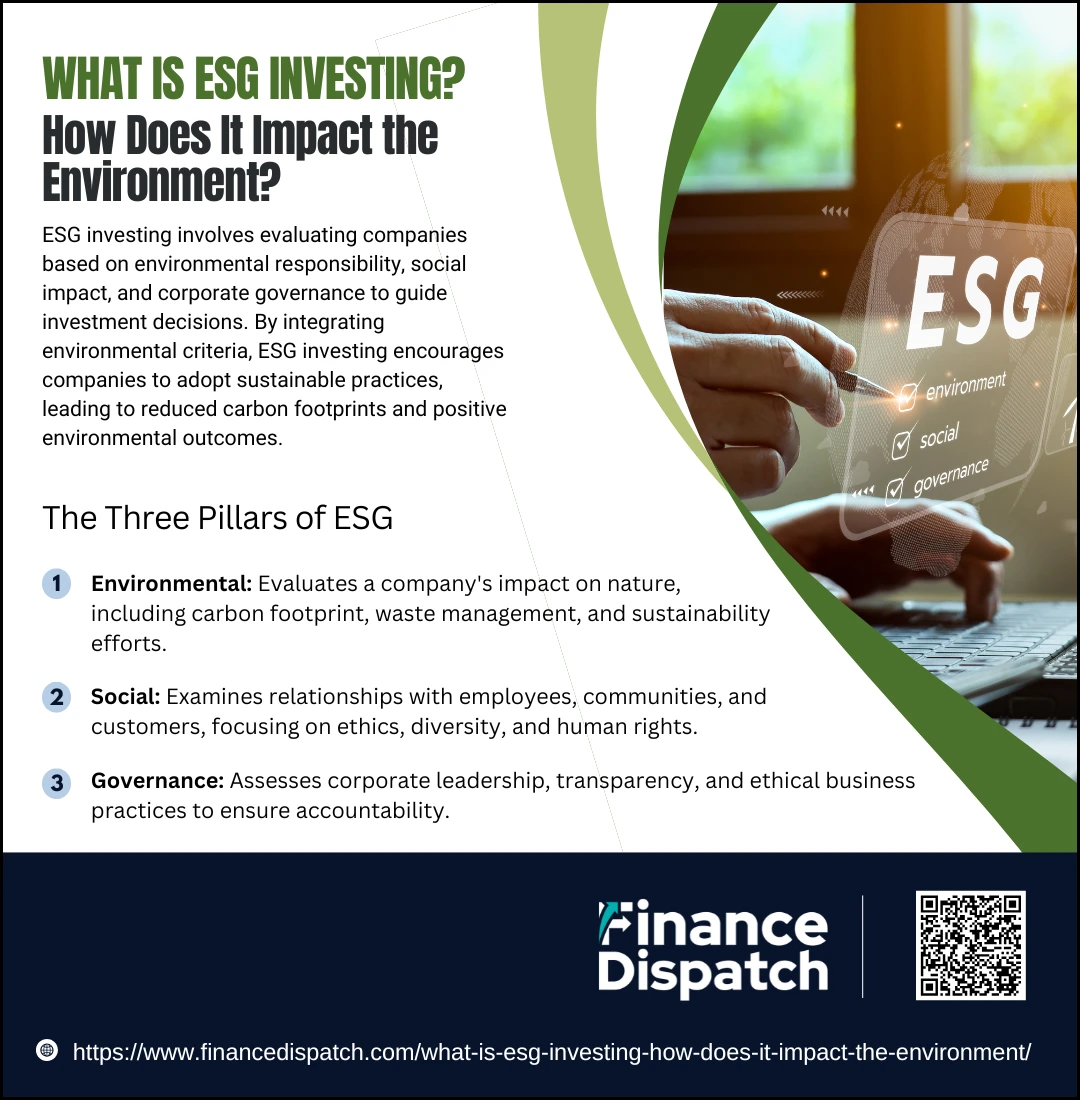 The Three Pillars of ESG
The Three Pillars of ESG
The foundation of ESG investing lies in its three key components: Environmental, Social, and Governance. These pillars serve as a framework for assessing a company’s sustainability and ethical performance, beyond traditional financial metrics. Each pillar focuses on a different aspect of a company’s impact—whether it’s on the planet, its people, or its leadership. Together, they provide a comprehensive evaluation that helps investors make informed decisions, supporting businesses that prioritize long-term responsibility and resilience. Here’s a closer look at each of the three pillars of ESG:
1. Environmental
Focuses on how a company interacts with and impacts the natural world. This includes their efforts to reduce pollution, conserve energy, manage waste, and reduce carbon emissions. Key factors include:
- Carbon footprint and greenhouse gas emissions.
- Waste management and recycling efforts.
- Resource conservation, including water and energy usage.
- Commitment to sustainable and green technologies.
2. Social
Examines how a company manages relationships with its employees, suppliers, customers, and communities. A strong social performance ensures that businesses operate ethically and contribute to societal well-being. Key factors include:
- Labor practices, workplace safety, and employee welfare.
- Diversity and inclusion within the workforce.
- Community engagement and contributions to local initiatives.
- Protection of human rights and fair business practices.
3. Governance
Assesses the quality of a company’s leadership and its commitment to accountability and transparency. Strong governance practices ensure that a company is run ethically and responsibly. Key factors include:
- Board diversity, structure, and independence.
- Executive compensation and alignment with long-term goals.
- Transparency in financial reporting and audits.
- Adherence to ethical business practices, including anti-corruption measures and shareholder rights.
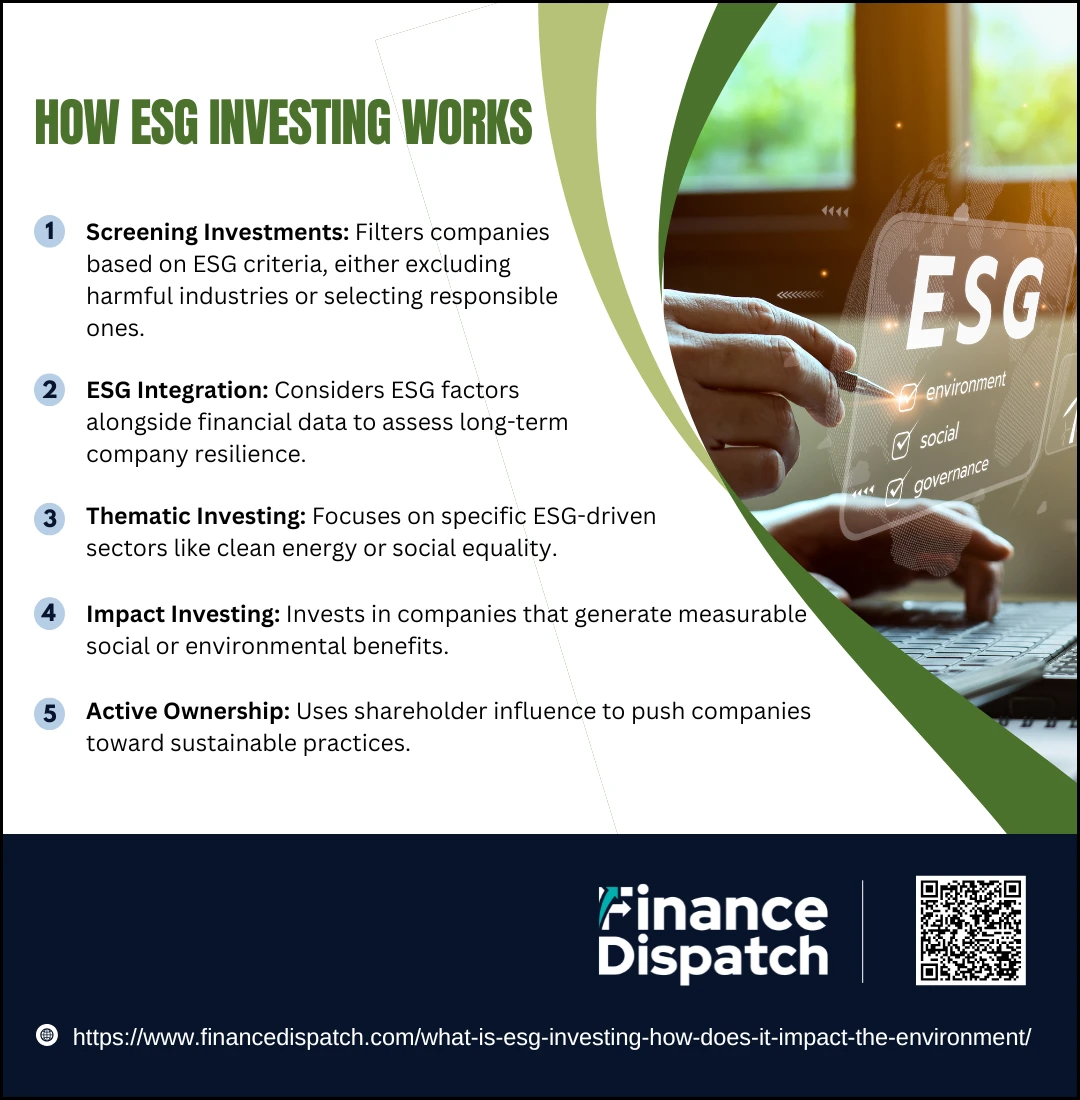 How ESG Investing Works
How ESG Investing Works
ESG investing goes beyond financial metrics by incorporating Environmental, Social, and Governance factors into the investment process. This method allows investors to evaluate companies not only on their profitability but also on their long-term sustainability and ethical performance. By integrating these additional considerations, ESG investing helps investors align their portfolios with their values, supporting companies that prioritize responsible business practices while still aiming for strong financial returns. The approach encourages businesses to adopt strategies that contribute positively to society, the environment, and good corporate governance. Below are the common strategies used in ESG investing:
1. Screening Investments
Investors employ screening methods to filter companies based on their ESG practices. Negative screening excludes businesses that engage in harmful activities, such as tobacco production, firearms manufacturing, or fossil fuel extraction. Positive screening focuses on companies excelling in areas like renewable energy, diversity initiatives, or eco-friendly practices, ensuring that the investments align with specific environmental or social values.
2. ESG Integration
In ESG integration, investors assess how ESG factors affect a company’s financial health and potential for long-term success. By considering elements like climate risks, employee relations, or management transparency alongside traditional financial data, investors can gain a clearer picture of the company’s future prospects and resilience against ESG-related challenges.
3. Thematic Investing
Thematic investing involves focusing on industries or sectors that align with particular ESG goals. For example, investors might focus on the clean energy sector, sustainable agriculture, or companies that promote gender equality. This strategy allows investors to target specific ESG issues they are passionate about, directing funds toward solutions that drive positive change.
4. Impact Investing
Impact investing is aimed at generating measurable positive outcomes for society or the environment, in addition to financial returns. For example, an investor might fund a company that provides clean water to underserved communities or invests in renewable energy projects. Unlike ESG integration, which seeks to mitigate risks, impact investing actively seeks to create social or environmental value through the investments made.
5. Active Ownership
Active ownership involves investors using their position as shareholders to influence a company’s practices. This can include engaging with management on sustainability issues, voting on shareholder resolutions that address ESG concerns, or pushing for greater transparency in ESG reporting. Active ownership allows investors to directly advocate for better corporate behavior, helping to steer companies toward more sustainable practices.
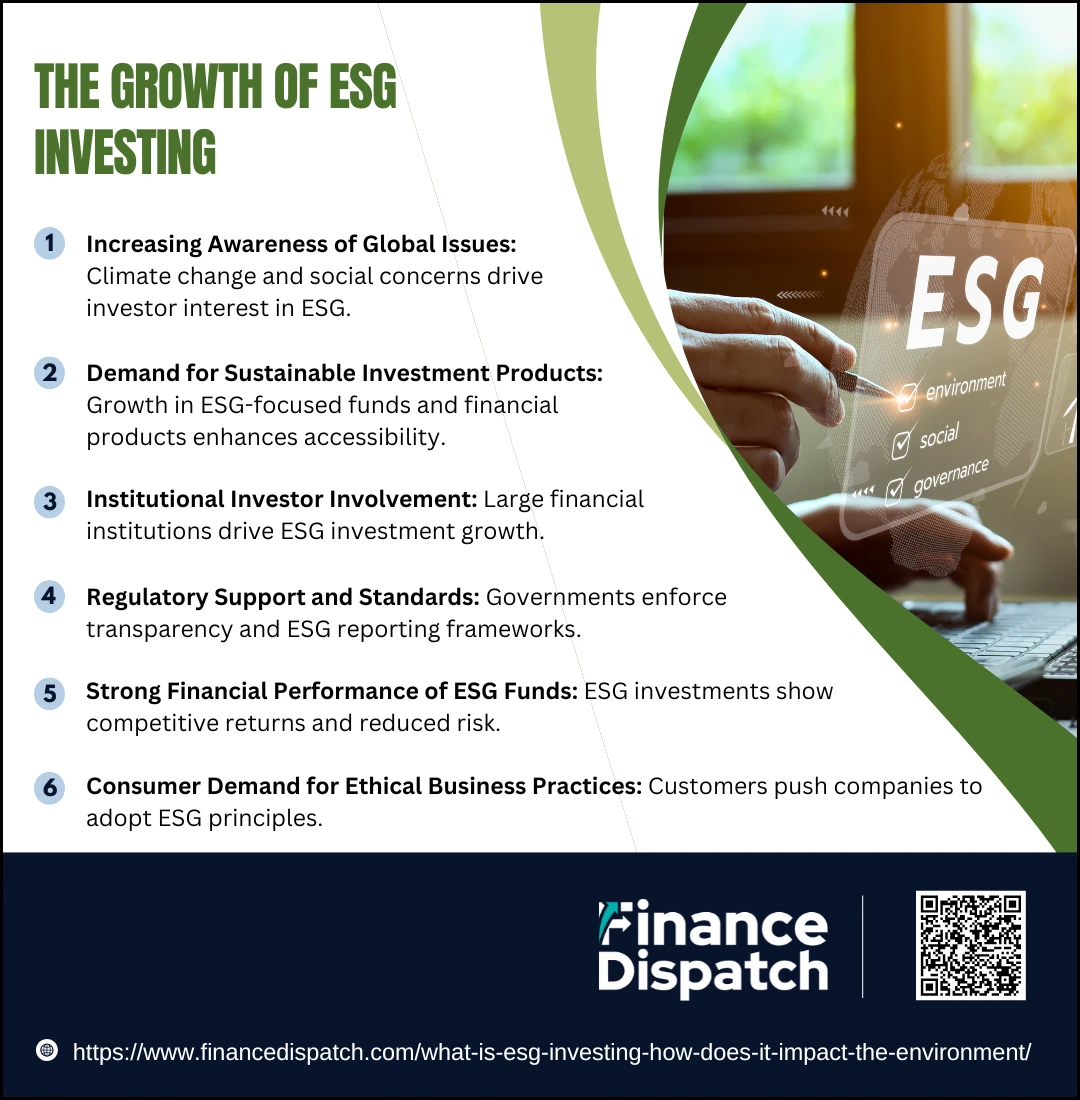 The Growth of ESG Investing
The Growth of ESG Investing
In recent years, ESG investing has seen remarkable growth as more investors and institutions recognize the long-term benefits of integrating sustainability into financial decisions. This shift towards responsible investing reflects an increasing awareness of global challenges such as climate change, social inequality, and corporate governance failures. As demand for sustainable investment options rises, both individual and institutional investors are actively seeking out companies that prioritize ESG principles. Here’s a look at the key factors driving the growth of ESG investing:
1. Increasing Awareness of Global Issues
The growing urgency of climate change, human rights concerns, and corporate accountability has heightened public awareness. As people become more conscious of these issues, they are increasingly choosing to invest in companies that align with their values and contribute to positive social and environmental change.
2. Demand for Sustainable Investment Products
The rise of ESG-focused mutual funds, exchange-traded funds (ETFs), and other financial products has made it easier for investors to include ESG considerations in their portfolios. These products offer a diverse range of options that cater to different values, whether focusing on renewable energy, ethical business practices, or social equity.
3. Institutional Investor Involvement
Large institutional investors, such as pension funds and asset managers, have significantly boosted the growth of ESG investing. Organizations like the United Nations Principles for Responsible Investment (UNPRI) have brought together thousands of institutional investors to promote responsible investment strategies, directing trillions of dollars toward companies with strong ESG practices.
4. Regulatory Support and Standards
Governments and regulators worldwide are increasingly mandating transparency in ESG reporting and encouraging companies to disclose their environmental and social practices. The introduction of frameworks like the Task Force on Climate-related Financial Disclosures (TCFD) and the Global Reporting Initiative (GRI) has helped standardize ESG metrics, making it easier for investors to assess companies’ sustainability efforts.
5. Strong Financial Performance of ESG Funds
Studies have shown that ESG-focused investments can yield competitive financial returns while mitigating risks. As more research highlights the correlation between strong ESG practices and long-term profitability, investors are more confident that integrating ESG into their portfolios will not only align with their values but also lead to positive financial outcomes.
6. Consumer Demand for Ethical Business Practices
Consumers increasingly expect companies to take responsibility for their impact on society and the environment. This pressure has driven companies to adopt ESG principles, leading to greater investment opportunities for those supporting sustainable and ethical business practices.
ESG Investing’s Impact on the Environment
ESG investing plays a pivotal role in driving positive environmental change. By directing funds toward companies that prioritize sustainability, ESG investors help reduce the environmental impact of industries that contribute to climate change, pollution, and resource depletion. This type of investment encourages businesses to adopt practices that conserve natural resources, reduce waste, and promote renewable energy. As more capital flows into environmentally responsible companies, the pressure on less sustainable businesses to change grows, ultimately supporting the global transition to a more sustainable future. Here’s a comparison of the positive and negative environmental impacts of ESG investing:
| Positive Impact | Negative Impact |
| Promotion of Renewable Energy: Funds directed to clean energy solutions, such as solar and wind, accelerate the transition to renewable power sources. | Greenwashing Risks: Some companies may exaggerate or misrepresent their environmental initiatives to attract ESG investors, which undermines the credibility of ESG investing. |
| Reduced Carbon Emissions: ESG investments encourage companies to adopt carbon reduction strategies, including energy efficiency measures and sustainable production practices. | Inconsistent Standards: The lack of universal ESG standards may result in differing levels of environmental commitment across industries, making it difficult for investors to evaluate true sustainability. |
| Resource Conservation: Companies that prioritize ESG tend to use natural resources more efficiently, helping to conserve water, reduce deforestation, and minimize waste. | Short-Term Focus: Some investors may focus more on immediate financial returns rather than long-term environmental impact, leading to investments that aren’t fully aligned with sustainable practices. |
| Eco-Friendly Innovations: ESG investing fosters the development of green technologies and sustainable products, further reducing environmental harm. | Limited Impact in Certain Sectors: While ESG investing encourages sustainability, some industries (like heavy manufacturing) may struggle to meet environmental standards, limiting the overall impact. |
ESG and Climate Change
Climate change is one of the most pressing global challenges today, and ESG investing plays a critical role in addressing its impacts. By prioritizing environmental criteria, ESG investors are actively encouraging companies to reduce their carbon footprints, adopt clean energy technologies, and implement sustainable practices. This focus on climate change aligns financial capital with efforts to mitigate the effects of global warming, reduce greenhouse gas emissions, and promote resilience in the face of extreme weather events. As the world shifts toward a low-carbon economy, ESG investing not only helps combat climate change but also supports companies that are at the forefront of environmental innovation. Through this strategic alignment, ESG investing accelerates the transition to sustainable energy systems and fosters long-term environmental protection, ensuring a healthier planet for future generations.
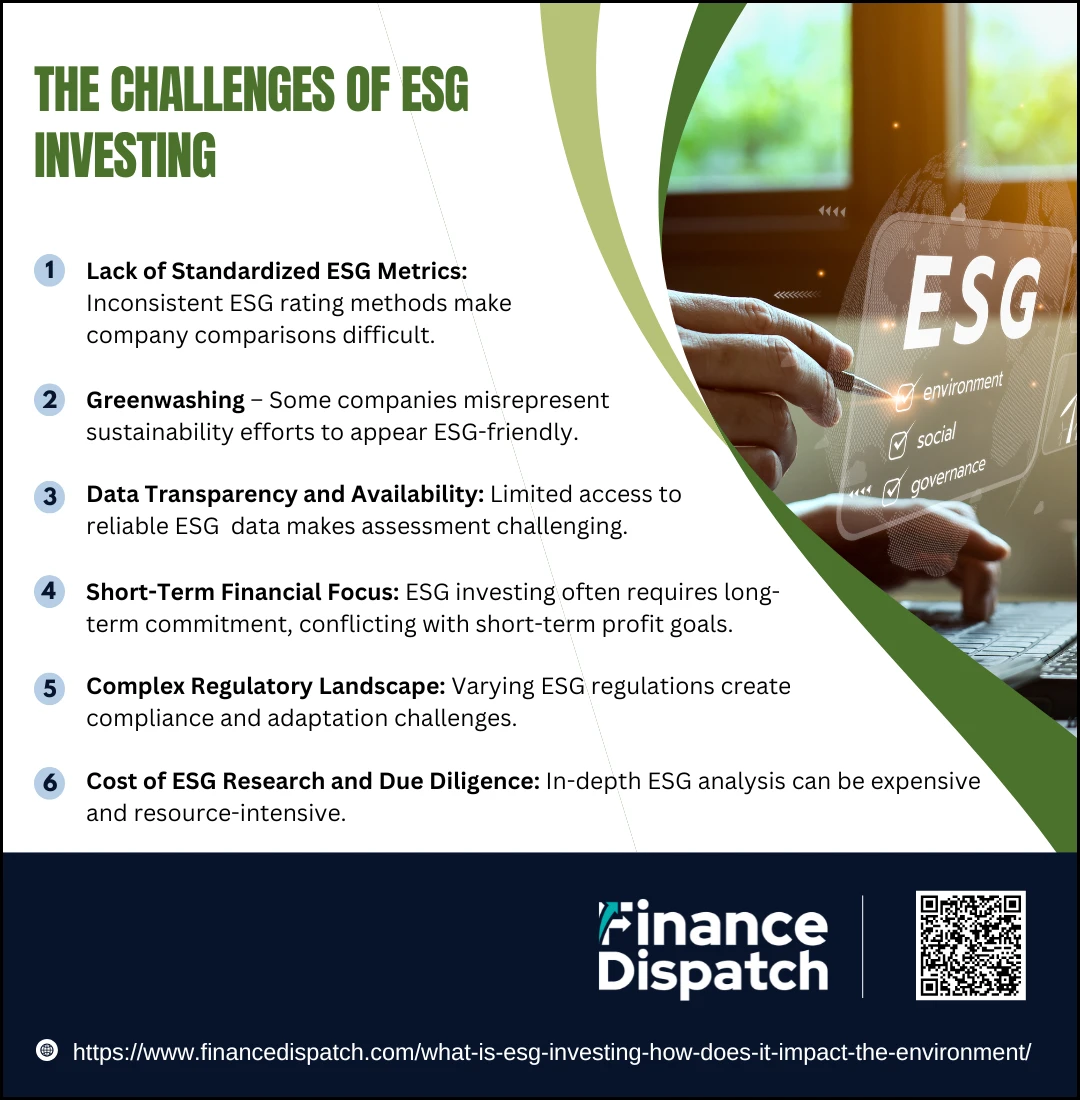 The Challenges of ESG Investing
The Challenges of ESG Investing
While ESG investing offers a promising approach to aligning financial goals with positive environmental, social, and governance outcomes, it is not without its challenges. As this investment strategy grows in popularity, it faces several obstacles that can complicate the evaluation and implementation of sustainable investment practices. From inconsistent standards to the risk of greenwashing, ESG investors must navigate a complex landscape to ensure their investments align with genuine sustainability goals. Here are some of the key challenges associated with ESG investing:
1. Lack of Standardized ESG Metrics
One of the biggest hurdles in ESG investing is the absence of universally accepted standards for measuring a company’s ESG performance. Different organizations use varied methodologies, leading to discrepancies in how companies are rated. This makes it difficult for investors to compare companies consistently and ensure they are investing in truly sustainable businesses.
2. Greenwashing
Greenwashing occurs when companies overstate or misrepresent their environmental efforts to appear more sustainable than they actually are. This poses a risk to ESG investors, as it becomes challenging to distinguish between companies that genuinely prioritize sustainability and those simply seeking to capitalize on the growing demand for ESG-friendly investments.
3. Data Transparency and Availability
Reliable and comprehensive ESG data is not always readily available, particularly for smaller companies or those in regions with weaker regulatory oversight. Without access to detailed information, investors may struggle to assess a company’s true ESG performance and its commitment to sustainable practices.
4. Short-Term Financial Focus
ESG investing often requires a long-term perspective, but many investors may be more focused on short-term financial returns. This mismatch can create pressure for companies to prioritize immediate profitability over sustainable practices, potentially undermining the long-term benefits of ESG investing.
5. Complex Regulatory Landscape
The evolving nature of ESG regulations, particularly in different regions, can create confusion and compliance challenges for both investors and companies. As governments introduce new standards for sustainability reporting, businesses must adapt quickly, and investors must stay informed to avoid potential risks related to non-compliance or regulatory changes.
6. Cost of ESG Research and Due Diligence
Conducting thorough ESG research and due diligence can be resource-intensive and costly. Investors may need to rely on third-party research firms or engage in extensive analysis to ensure the companies they invest in meet their ESG criteria, adding an extra layer of expense to the investment process.
ESG Investing vs. Traditional Investing
ESG investing and traditional investing both aim to generate returns, but they differ significantly in the criteria used to evaluate potential investments. While traditional investing focuses primarily on financial performance, ESG investing incorporates environmental, social, and governance factors into the decision-making process. This distinction leads to different approaches in assessing risk, identifying growth opportunities, and aligning investments with broader ethical and sustainability goals. Here’s a comparison of ESG investing and traditional investing:
| Feature | ESG Investing | Traditional Investing |
| Focus | Incorporates environmental, social, and governance factors alongside financial analysis. | Focuses primarily on financial metrics and profitability. |
| Investment Criteria | Looks at a company’s sustainability, social impact, and governance practices. | Relies solely on financial performance and market potential. |
| Risk Assessment | Considers ESG risks such as climate change, social issues, and governance failures. | Focuses on market risks, financial volatility, and economic factors. |
| Investor Motivation | Aligns investments with personal values related to sustainability and social responsibility. | Primarily driven by financial returns, regardless of ethical or environmental concerns. |
| Market Impact | Supports companies that prioritize long-term sustainability and ethical practices. | Supports companies based purely on their financial performance, irrespective of their social or environmental impact. |
| Performance Measurement | Measures success based on both financial returns and the positive environmental or social impact created. | Success is measured solely by financial returns and market growth. |
| Investment Horizon | Long-term focus, with an emphasis on sustainable growth and mitigating future risks. | Often focuses on short-term profits and immediate financial returns. |
Real-World Examples of ESG Investing
Real-world examples of ESG investing showcase how businesses and investors are successfully aligning financial goals with environmental and social responsibility. For instance, Tesla, a leader in the electric vehicle market, has attracted significant ESG investment due to its commitment to reducing carbon emissions and promoting sustainable energy solutions. Tesla’s efforts in producing electric cars and renewable energy products align directly with environmental goals, making it a key player for ESG-focused investors. Another example is Patagonia, a clothing company renowned for its environmental activism, including using recycled materials and committing to fair labor practices. Investors who prioritize social and environmental impact have supported such companies, knowing they are driving positive change while also generating returns. Additionally, BlackRock, one of the world’s largest investment management firms, has committed to increasing its investments in sustainable assets and has been actively incorporating ESG factors into its investment strategies, urging companies to improve their environmental performance and governance. These examples demonstrate how ESG investing can lead to tangible outcomes, benefiting both society and the environment, while still providing financial growth.
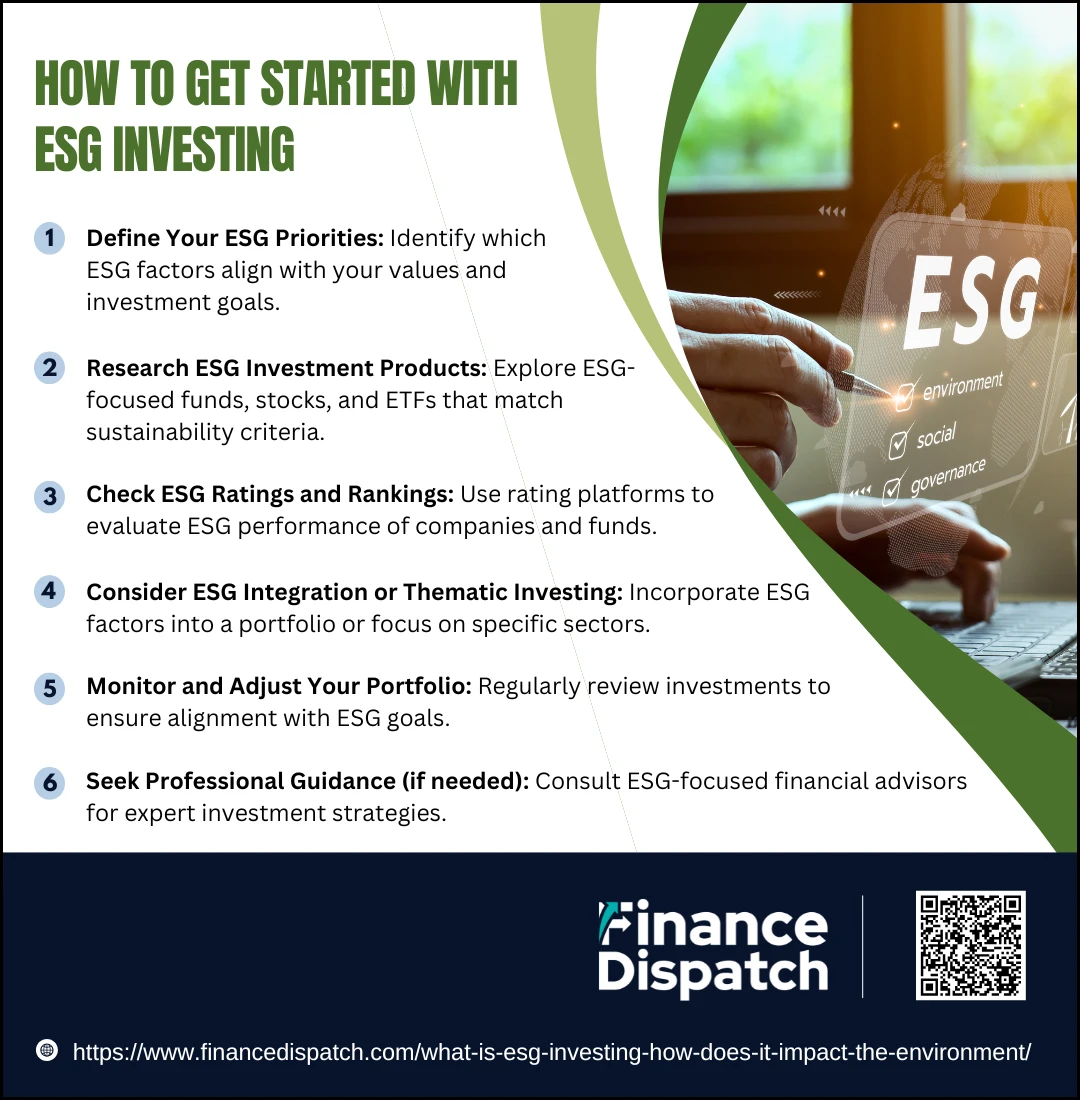 How to Get Started with ESG Investing
How to Get Started with ESG Investing
Getting started with ESG investing is easier than ever, thanks to the growing number of investment options and platforms that cater to socially responsible and sustainable practices. Whether you’re an experienced investor or a newcomer, aligning your portfolio with your values requires a thoughtful approach. By considering ESG factors, you can ensure that your investments not only generate financial returns but also contribute to the positive environmental, social, and governance impact. Here are some key steps to help you begin your ESG investing journey:
1. Define Your ESG Priorities
The first step is to determine what matters most to you. Whether it’s environmental sustainability, social equity, or ethical governance, understanding which ESG factors align with your values will guide your investment choices.
2. Research ESG Investment Products
Explore ESG-focused funds, such as mutual funds, exchange-traded funds (ETFs), or individual stocks that meet your sustainability criteria. Look for products that specifically target areas like clean energy, social justice, or corporate governance.
3. Check ESG Ratings and Rankings
Use third-party ESG rating platforms like MSCI, Sustainalytics, or Morningstar to evaluate companies and funds based on their ESG performance. These platforms provide valuable insights into how companies align with ESG standards.
4. Consider ESG Integration or Thematic Investing
You can either integrate ESG factors into your existing portfolio or focus on specific themes that interest you. ESG integration involves evaluating companies with strong ESG practices, while thematic investing targets sectors like renewable energy or social equity.
5. Monitor and Adjust Your Portfolio
ESG investing is an ongoing process. Regularly review your investments to ensure they continue to meet your criteria and stay updated on changes in ESG standards. Make adjustments as needed to align with evolving goals or new opportunities.
6. Seek Professional Guidance (if needed)
If you’re unsure about how to get started or want more tailored advice, consider working with a financial advisor who specializes in ESG investing. They can help you navigate the complexities and make informed decisions based on your financial and social objectives.
Conclusion
ESG investing represents a powerful way for individuals and institutions to align their financial goals with their values, supporting companies that prioritize environmental sustainability, social responsibility, and strong governance. As the world faces pressing challenges like climate change, inequality, and corporate corruption, ESG investing offers a path toward a more sustainable and ethical future. While it comes with its own set of challenges, such as the lack of standardized metrics and the risk of greenwashing, the benefits of investing in companies that prioritize long-term responsibility are clear. By getting started with ESG investing, you not only have the opportunity to generate financial returns but also to contribute to the broader movement toward a more sustainable and just world. As this investment strategy continues to grow, it offers both a financial and ethical roadmap for shaping the future of investing.



